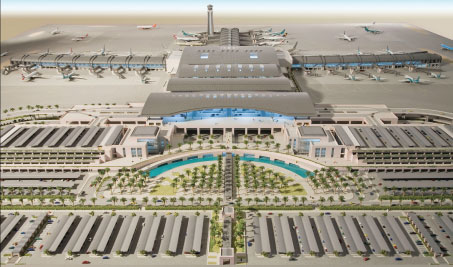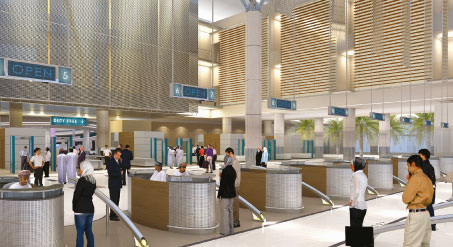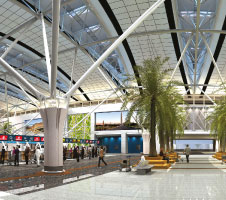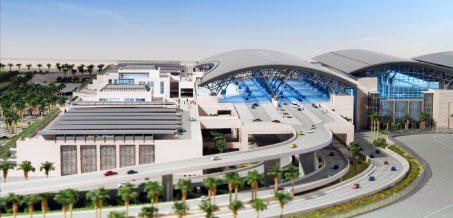
Muscat International Airport’s new terminal will have an initial capacity of 12 million passengers per year when it opens in 2014. Further expansion in three subsequent phases will increase capacity to 24 million, 36 million, and ultimately 48 million passengers per year.
Oman Airports Management Company (OAMC) is experiencing strong growth at its airports. Muscat International Airport saw throughput reach a record 7.5 million passengers in 2012 – a +16% increase year-on-year. Meanwhile, Salalah Airport – a growing tourist destination – handled more than 600,000 passengers, representing a rise of +23% on the previous year.
The record passenger numbers achieved at Muscat International Airport are indicative of the growth trend being witnessed in Oman’s aviation industry. Growth is being driven by factors including fleet and route expansion by the airlines serving Muscat; this in turn is being fuelled by the development of Oman’s tourism industry, and strong industrial and economic activity. Indeed, Muscat’s status as a growing industrial hub is highlighted by the fact that the airport handled more than 100,000 tonnes of freight for the first time in 2012.
With growth figures measuring at around the +15% mark for the past five years, just how big can the capital’s airport get?
“GDP in Oman is strong, it’s an increasingly popular tourist destination, there’s development and construction going on all over the country, the nation’s flag bearer, Oman Air, is expanding – there’s no reason to not expect +15% growth yet again for 2013,” commented Vic Allen, Acting CEO, OAMC. “We’re stretching our resources for now – the airport has been operating at capacity for five years, but in a couple of years our new airport will be open.”
The new terminal being constructed at Muscat International is described by Allen as a “new airport”, such is the impact it will have. “The existing airport was built in the early 1970s and is well past its use-by date. The new airport will be a revolutionised experience,” he added.

Allen: “GDP in Oman is strong, it’s an increasingly popular tourist destination, there’s development and construction going on all over the country, the nation’s flag bearer, Oman Air, is expanding – there’s no reason to not expect +15% growth yet again for 2013.”
With a total floor space of 334,995sqm, Muscat’s new terminal will have an initial capacity of 12 million passengers per year when it opens in 2014. Further expansion in three subsequent phases, which will take place according to demand, will increase capacity to 24 million, 36 million, and ultimately 48 million passengers per year. “It will be hugely beneficial, not just for those working at the airport and the residents of Oman, but also for the passengers. A second runway will be added, and floor space will be ten times the size of the existing terminal. It will roughly increase the capacity of the airport five times over,” explained Allen.
Meanwhile, the new terminal at Salalah Airport will also open in 2014, with an initial capacity of one million passengers per year. It has, similarly, been designed to allow for subsequent phased expansion in line with demand, with an ultimate annual capacity of six million passengers. Salalah Airport’s expansion is part of a strategic aim to further develop Salalah as a tourist destination. Located 1,000km south of Muscat, and with a much cooler climate during the summer months, it is described as a magnet for tourists.
Airline expansion

The new terminal being constructed at Muscat International is described as a “new airport”, such is the impact it will have. Allen: “The existing airport was built in the early 1970s and is well past its use-by date. The new airport will be a revolutionised experience.”
It is not just the airports that are expanding – Oman Air, in order to cater to its ever-increasing business, recently expanded its fleet with two wet-leased 737-800s. Air Arabia, meanwhile, launched its first direct flights to Salalah Airport in 2012, becoming the third airline to operate year-round services to the airport after Oman Air and Air India Express.
“The aim is to increase traffic between Oman and the subcontinent – Pakistan and India in particular – as well as frequencies on existing routes,” said Allen. “South Asia is our main market though. It’s driven by a vast amount of migrant labour. Muscat International Airport itself actually had a number of young Omani nationals working the porter service. We recently outsourced the porter service to a private company so that we could train the young Omani’s in higher-skilled jobs.”
Both Muscat and Salalah airports adopted this new approach to employment following a string of recent government initiatives to combat unemployment and poor quality of employment in Oman. As a result, over 25 specially trained new positions have been created in order to grant locals more specialist roles, such as fire fighters and operations officers.

The first phase of the development at Muscat is due to be opened by the third quarter of 2013, with more development announcements to be made then.
Enhancing the passenger experience
OAMC’s efforts to improve the passenger experience include the launch of a new smartphone app for Muscat International Airport. The app features live flight information, information pertaining to airport services such as lounges, retail, food & beverage, parking, and taxi booking, as well as information on Oman itself, including weather and currency details. The app is available for both iPhone and Android devices, and in both English and Arabic. “The uptake for smartphones is beginning to eclipse that of home computers, and we’re beginning to focus on mobile apps more than anything else,” commented Allen. “It’s not just keeping up with the market – there’s an actual need for mobile apps. If people want to see if their flight is on time before they leave home they’ll use their tablet or smartphone, it’s how it works out here. It’s all a part of our continuing work to communicate with the people of Oman.”
The first phase of the development at Muscat is due to be opened by the third quarter of this year, with more development announcements to be made then. The new terminal developments taking place at Muscat and Salalah, coupled with the healthy double-digit growth being experienced by both airports, is indicative of the growth trend being experienced in Oman. That growth looks set to continue for the foreseeable future, and the planned phased expansion of the airports will ensure a smooth passenger experience.







